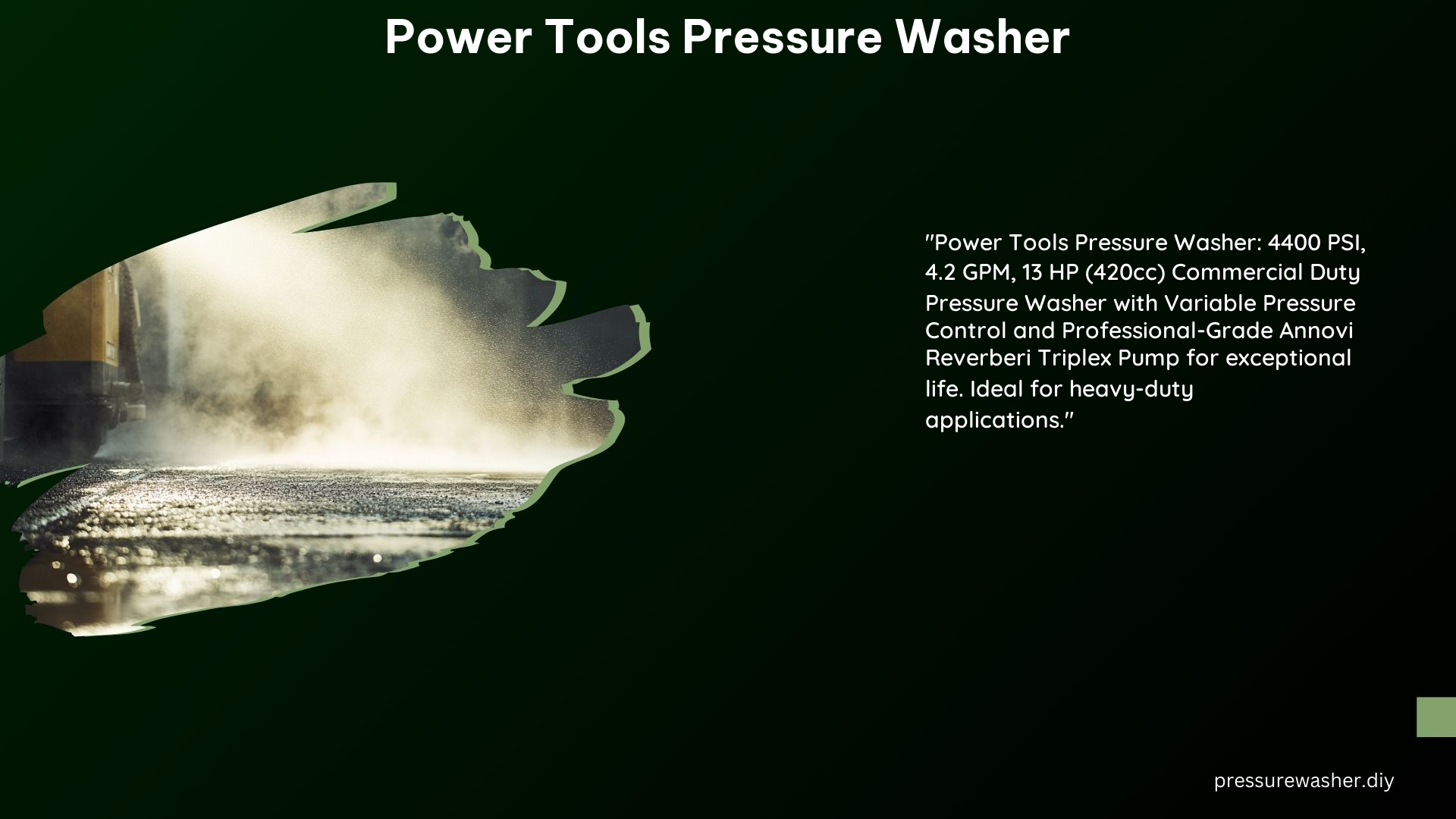Power tools pressure washers are versatile cleaning devices that utilize high-pressure water streams to efficiently clean a wide range of surfaces, from driveways and patios to vehicles and outdoor furniture. These powerful tools come in various types, including electric, gas, and commercial models, each with its own set of features, performance capabilities, and technical specifications.
Performance Power Pressure Washer Instructions
Electric Pressure Washers
-
RYOBI: RYOBI offers a range of electric pressure washers suitable for light to medium-duty cleaning tasks. Their models typically feature pressure ratings ranging from 1,600 to 2,300 PSI and flow rates between 1.2 to 1.5 GPM, making them ideal for tasks like cleaning cars, patio furniture, and small outdoor areas.
-
Hart Tools: Hart Tools provides electric pressure washers with brushless motors, such as the 2500 PSI model, which offers improved performance and efficiency compared to traditional induction motors. These washers can deliver up to 1.2 GPM of water flow, providing ample cleaning power for medium-duty tasks.
Gas Pressure Washers
-
Hart Tools: Hart Tools offers gas pressure washers with high pressure ratings, such as the 3100 PSI model, which is suitable for heavy-duty cleaning tasks. These gas-powered units typically feature Honda or Briggs & Stratton engines and can deliver up to 2.5 GPM of water flow, making them ideal for tackling tough jobs like cleaning driveways, decks, and siding.
-
Harbor Freight Tools: Harbor Freight Tools provides gas pressure washers with high pressure ratings, such as the 4400 PSI model, designed for commercial use. These powerful units can generate up to 4.0 GPM of water flow, making them well-suited for large-scale cleaning projects, such as cleaning industrial equipment or prepping surfaces for painting.
Power It Pressure Washer Instructions

Electric Pressure Washers
-
Hart Tools: Hart Tools offers electric pressure washers with advanced features like brushless motors and variable pressure control. These models allow users to adjust the pressure output to suit the specific cleaning task, ranging from 1,000 to 2,500 PSI, and can deliver up to 1.2 GPM of water flow.
-
Harbor Freight Tools: Harbor Freight Tools provides electric pressure washers with built-in quick connect couplers and onboard detergent tanks for improved cleaning and soap application. Their models typically offer pressure ratings between 1,500 to 2,000 PSI and flow rates of 1.3 to 1.6 GPM.
Gas Pressure Washers
-
Hart Tools: Hart Tools offers gas pressure washers with high pressure ratings and advanced features like turbo nozzles and surface cleaners. Their gas-powered models can generate up to 3,100 PSI of pressure and deliver 2.5 GPM of water flow, making them well-suited for heavy-duty cleaning tasks.
-
Harbor Freight Tools: Harbor Freight Tools provides gas pressure washers with professional-grade pumps and ceramic-coated pistons for exceptional durability. These units can produce up to 4,400 PSI of pressure and 4.0 GPM of water flow, making them ideal for commercial or industrial cleaning applications.
Pressure Washer with Generator
Some pressure washers come equipped with built-in generators, which provide a reliable power source for the washer. These models are particularly useful for outdoor cleaning tasks where a power outlet may not be readily available. The generators in these pressure washers typically range from 2,000 to 4,000 watts, ensuring ample power to operate the high-pressure water pump and any additional accessories.
Safety Precautions
-
Wear Protective Gear: Always wear protective gear such as gloves, safety glasses, and a face mask to prevent injury from high-pressure water streams and debris. The high-pressure water can cause serious injury if not handled properly.
-
Read the Manual: Carefully read the user manual to understand the specific safety precautions and operating instructions for your pressure washer. This will help you use the equipment safely and effectively.
-
Maintain Distance: Maintain a safe distance from the nozzle, typically 6 to 12 inches, to avoid injury and ensure effective cleaning. The high-pressure water can cause damage or injury if the nozzle is held too close to the surface.
-
Avoid Sensitive Surfaces: Avoid using pressure washers on sensitive surfaces like windows, doors, and painted walls to prevent damage. The high-pressure water can easily crack or chip these delicate surfaces.
Choosing the Right Pressure Washer
-
Determine the Task: Identify the specific cleaning task and the surface to be cleaned to choose the right pressure washer. Light-duty tasks like car washing may only require a 1,500 PSI electric model, while heavy-duty jobs like cleaning concrete driveways may need a 4,000 PSI gas-powered unit.
-
Pressure Rating: Select a pressure washer with a suitable pressure rating for the task, ranging from light-duty (1,500 PSI) to heavy-duty (4,000 PSI). Higher pressure ratings generally provide more cleaning power but may also require more caution and skill to use safely.
-
Power Source: Choose between electric and gas-powered models based on your power needs and availability. Electric pressure washers are typically quieter and more environmentally friendly, while gas-powered models offer more power and portability.
-
Additional Features: Consider additional features like surface cleaners, turbo nozzles, and detergent tanks to enhance cleaning efficiency and versatility. These features can make specific cleaning tasks easier and more effective.
Technical Specifications
-
Pressure Rating: Measured in pounds per square inch (PSI), pressure washers can range from 1,500 PSI for light-duty tasks to 4,400 PSI for heavy-duty commercial applications.
-
Flow Rate: Measured in gallons per minute (GPM), flow rates can vary from 1.3 GPM for smaller electric models to 4.2 GPM for large gas-powered pressure washers. Higher flow rates generally provide more cleaning power.
-
Motor Type: Pressure washers can be powered by either electric or gas-powered motors. Some models feature brushless motors, which offer improved efficiency and performance compared to traditional induction motors.
-
Pump Type: Pressure washers typically use triplex pumps with brass manifolds and ceramic-coated pistons for enhanced durability and long service life. These professional-grade pumps can withstand the high pressures and continuous use required for heavy-duty cleaning tasks.
References
- The Home Depot. (n.d.). Pressure Washers. Retrieved from https://www.homedepot.com/b/Outdoors-Outdoor-Power-Equipment-Pressure-Washers/N-5yc1vZbxbe
- Hart Tools. (n.d.). Pressure Washers. Retrieved from https://harttools.com/collections/pressure-washers
- Amazon. (n.d.). Pressure Washers. Retrieved from https://www.amazon.com/Pressure-Washers/b?ie=UTF8&node=552856
- Harbor Freight Tools. (n.d.). Pressure Washers. Retrieved from https://www.harborfreight.com/lawn-garden/outdoor-power-tools/pressure-washers.html
- Clean Pro Supply. (n.d.). Pressure Washing Equipment & Tools. Retrieved from https://www.cleanprosupply.com/pressure-washing-equipment-tools/
